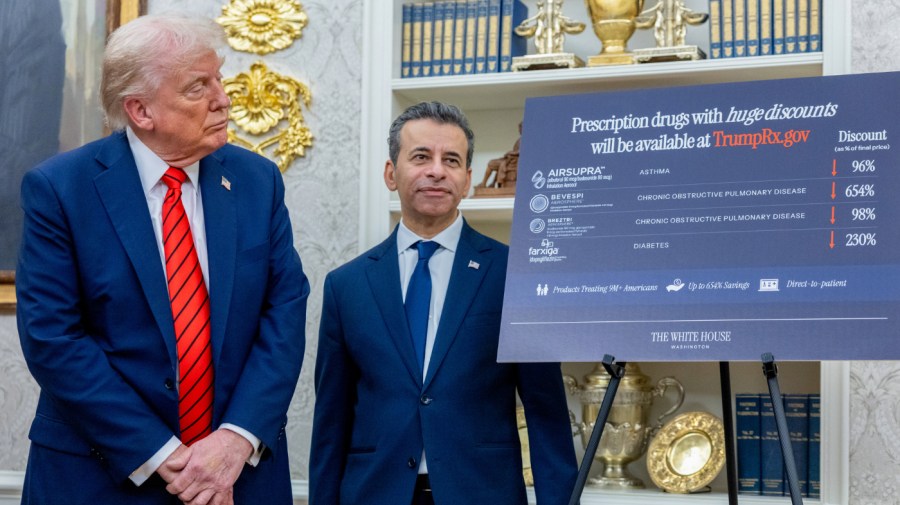Trump’s lower drug price push comes at a cost — here’s an alternative

On Oct. 1, Pfizer agreed to lower the prices of some drugs in response to President Donald Trump’s executive order on most favored nation drug pricing.
The order threatens drugmakers who don’t reduce their U.S. prices to match what they charge abroad with punitive sanctions, including Medicare and Medicaid price ceilings, export restrictions and revocation of drug approvals. Days earlier, Trump threatened a 100 percent tariff on drugmakers who don’t plan on manufacturing domestically.
Cheaper medicine and stronger American industry are worthy goals, but these policies may do far more harm than good. New cures, access to medicine and the domestic industry that Trump seeks to support are at risk.
The president is rightly angry about Americans paying three or four times what citizens of comparable economies pay for the same medicines. This is largely because other countries’ public insurers negotiate patented drug prices directly with drugmakers, using their bulk-buying monopsony power to lower prices.
Conversely, America’s Centers for Medicaid and Medicare Services, which serves more than 160 million Americans, is legally prohibited from negotiating prices for all but a few drugs starting in 2026 under the Inflation Reduction Act. Instead, CMS generally pays prices pegged to America’s private market. This incentivizes drugmakers to inflate prices for drugs to private patients and insurers beyond market-dictated levels, since it lifts the price of everydrug bought by CMS.
This raw deal isn’t without benefits. The industry’s substantial profits in America mean that Americans have access to the latest and most pharmaceuticals. Countless new cures and high-paying American research and manufacturing jobs are also under threat if drugmakers are simply forced to lower their U.S. drug prices.
What we really need is for other countries to agree to pay a fairer share.
It costs billions to research, test, obtain approval for and market new drugs, including failed trials’ sunk costs. New projects are initiated based on expectations of future returns and revenue from existing sales. Even research-intensive pharmaceutical startups rely on expected returns to access the money they need from capital markets.
Less money for that research means fewer cures, job cuts and ultimately, fewer cheap generic drugs and manufacturing opportunities. One study showed that most favored nation-like policies could lead to 167 to 342 fewer new approved drugs over 18 years.
It’s also well-established that price controls cause shortages and reduce access to care. For instance, artificially suppressed drug prices could lead to lower payments to rural health care providers, forcing many to close.
Inducing other countries to pay more for their medications won’t be easy, but it’s doable. The U.S. has leverage as the world’s largest economy and the origin of major lifesaving cures.
Commitments for world governments to pay higher drug prices can be secured through agreements to withdraw tariff threats and lower trade barriers. This would also foster economic competition to the benefit of Americans in line with the president’s executive order on deregulation.
Imagine an American-led multilateral treaty on drug pricing. It could create a forum where government and industry representatives and experts can agree on international reference prices for patented drugs, adjusted for each state’s purchasing power parity. This would stop Americans already struggling with high living costs from shouldering an inequitable burden in funding global pharmaceutical innovation.
At home, Trump’s commendable “TrumpRx” initiative to help Americans find discounted medicines by linking them directly to drugmakers is a good starting point.
Examples of deregulation to reduce domestic prices include replacing or reforming the Medicare program that lets hospitals buy drugs at low cost while marking up prices for patients and insurers without passing on savings. The government can permit interstate insurance purchases, streamline new drug approval processes, liberalize drug importation and abolish tax penalties linking health insurance to employment.
Trump’s 100 percent tariff on drugs may force some manufacturing onshore, and it may create some domestic jobs that wouldn’t otherwise exist. But it would come at too high a cost. International dealmaking and deregulatory reforms will lower U.S. drug prices without compromising innovation.
Satya Marar is a research fellow at the Mercatus Center at George Mason University, specializing in competition, innovation and governance.